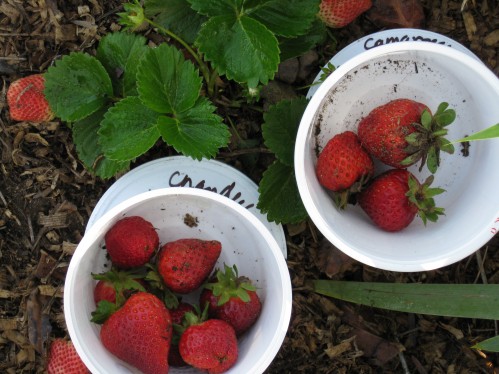Strawberry Savvy
 My first venture into growing my own strawberries, was purchasing by a fluke, two pony packs of Chandler strawberries. That was the winter we received a record 25 inches of rain or so, here in Southern California. I don't want to scare you, but from those original two pony packs I gave away 17 full nursery flats of Chandler strawberry plants to my enthusiastic garden friends that following spring. Needless to say, conditions must have been optimum.
My first venture into growing my own strawberries, was purchasing by a fluke, two pony packs of Chandler strawberries. That was the winter we received a record 25 inches of rain or so, here in Southern California. I don't want to scare you, but from those original two pony packs I gave away 17 full nursery flats of Chandler strawberry plants to my enthusiastic garden friends that following spring. Needless to say, conditions must have been optimum.
Picking my own sun-ripened strawberries for morning breakfast is always a delectable treat. My strawberries are so sweet and juicy, and incredibly flavorful. Once you have had your own strawberries, you will be spoiled, and never want anything but your home-grown. Here are some tips I have found growing strawberries in my kitchen garden:
1) Pick a sunny sloping spot with rich, well-draining, preferably acidic soil in your kitchen garden. Strawberry plants are perennials, but should be rotated out after three years, because the plants start to decline. Either replace "your strawberry patch" with new plants, or start cultivating a "new strawberry patch" with your young runner plants. If you don't have space in your garden, a planted strawberry pot or container works well, and is very attractive.
2) Mulch your strawberries with straw, or in my case, I use my compost mixture. This will keep your strawberries off of the soil, discourage bugs, and allow pristine berries to grow and ripen.
3) Provide adequate water. Strawberries need regular moderate watering.
4) If you have the room, I urge you to experiment with different strawberry varieties. Bear in mind there are three types of market strawberries, June-bearing, everbearing, and day-neutral varieties. June-bearing produce one crop of strawberries in early spring or early June. Generally speaking, these are the best quality strawberries you can grow in your garden. Everbearing varieties produce two crops one in June and one late summer. Day-neutral varieties can produce a continuous crop from June to frost. There are also alpine and musk strawberries which are not to be confused, and are a different species.
5) Pick your ripe strawberries regularly, and often. This also discourages bugs from enjoying your strawberries first.
6) After harvest, or in the winter, I prune back my strawberry plants. Be careful not to damage the crown of the plant for the following year. Some gardeners actually lightly mow the tops of their strawberry plants, but I prefer gentle pruning.
There are so many different strawberry varieties available to grow, buy regional strawberry varieties adapted to your particular area. This spring, I got "Strawberry Mania" and planted four different strawberry varieties, one type in each corner of my potager or kitchen garden. I thought it would be fun to experiment in taste, size, texture, and yield.
My point is, a "strawberry" is not just a strawberry. In the above photo, I planted and tasted my favorite, Chandler strawberry, and a new-to-me variety, Camarossa strawberry, both June-bearing varieties. I planted in two other corners, Eversweet and Sweetheart everbearing strawberries, which are also new-to-me varieties this year. Time will tell how they all will fare in my home-grown taste comparison.
Strawberries are so versatile in baking, cooking, preserves, summer desserts, salads, and simply fresh straight out of the garden. If you love strawberries, try planting your own strawberry patch. For more in depth information on growing strawberries, please refer to some of the amazing new books on edibles, Sunset's Western Garden Book of Edibles and Grocery Gardening, I have reviewed recently.
Please share tips from your strawberry patch. Please comment on the varieties of strawberries you grow.

